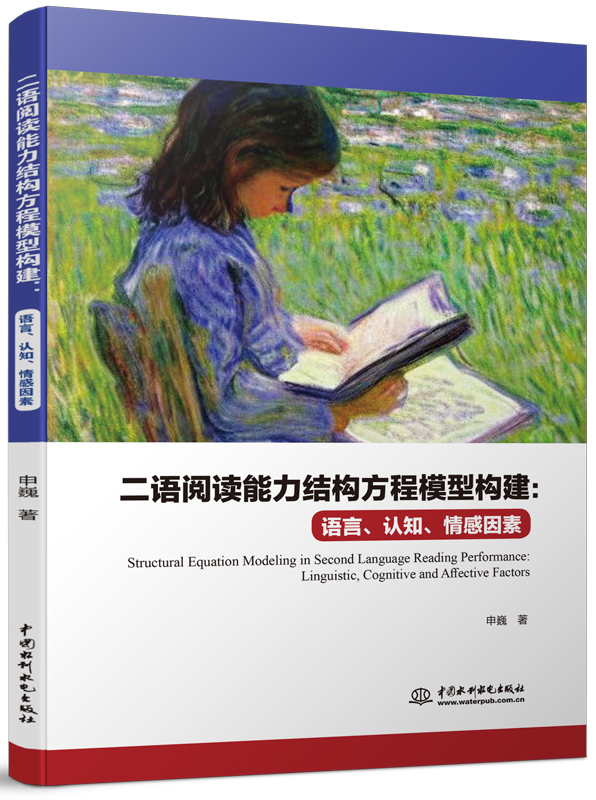二语阅读能力结构方程模型构建:语言、认知、情感因素

简介
本书特色
前言
章节列表
精彩阅读
下载资源
相关图书
本书采取定量研究的方法,通过词汇知识测试、阅读策略问卷、工作记忆测试、自我效能感问卷和阅读测试,获得量化数据,利用结构方程模型(SEM)等统计工具对获得的数据进行深挖和分析,探讨第二语言(二语)词汇知识、阅读策略、工作记忆、自我效能感和二语阅读理解之间的相互关系。通过构建二语阅读影响因素模型,试图发现我国二语学习者语言因素、认知因素、情感因素影响阅读能力的内在机制。
本书在理论上有助于二语阅读理论的进一步发展和完善,在研究设计和研究方法上对同类课题的开展有借鉴价值,在实践上对我国的英语阅读教学有启发和指导作用,适合对二语阅读理论、结构方程模型在二语习得中的应用等感兴趣的读者。
The findings of this study contribute to clarifying the inherent interrelationship and interaction among second language ( L2 ) vocabulary knowledge, reading strategy, working memory, self-efficacy and L2 reading comprehension with the construction of RS-VOC-WM-SELF-READ structural model, and providing theoretical and pedagogical implications for L2 reading teaching and learning.
阅读是一项复杂的认知活动,读者通过与文本交互获取信息,是获取知识、扩大词汇量、提高思维能力、学习写作风格的一项重要途径。
影响阅读理解的因素很多,从宏观上可以分为环境因素、文本因素和学习者因素三大类别。环境因素指阅读发生时读者所处的环境。文本因素指文本自身具有的各种特征,如文本的呈现方式、类型或体裁、文本的语言特征等。学习者因素对阅读理解的影响是指在阅读相同的文本时,由于个体差异的存在,不同的学习者对文本的理解能力不尽相同。这些个体差异包括年龄、性别、阅读动机、认知风格和语言水平等。就二语阅读理解而言,学习者因素可分为三类:第一类是语言知识;第二类是在阅读理解中普遍存在、不局限于特定语言的认知活动;第三类是情感因素。
本书研究的主要目的是揭示语言、认知和情感因素对阅读能力影响的内在机制。现有的二语阅读研究已证实语言因素中的词汇知识是二语阅读能力重要的预测因素之一,同时,阅读策略和工作记忆在认知领域对二语阅读也起到有效的作用。情感因素中的自我效能感与二语阅读理解之间存在正相关关系。但目前还没有足够的经验证据来确定二语阅读过程中词汇知识、阅读策略、工作记忆和自我效能感在多大程度上协同作用,从而使学习者表现出更高的阅读能力。
由于二语阅读过程的多面性及语言、认知、情感因素和二语阅读之间的复杂关系,本书采用结构方程模型(SEM)来阐明变量之间的直接和间接联系。SEM的优势在于其测量模型能够提高多指标变量的量化效度和信度,其结构模型能够将多个变量同时处于一个框架中,直观地展现它们之间的复杂关系。本书选择 SEM 进行数据分析,实际上是对二语阅读表现的归因因素的全面理解。
本书基于社会认知理论,通过厘清影响二语阅读的个体因素,构建二语阅读影响因素模型,旨在探讨二语学习者在二语阅读中的词汇知识、阅读策略、工作记忆和自我效能感等内在因素的相互作用,进一步尝试为二语阅读教学提供有效途径。
本书是在作者博士论文的基础上修改和润色而成。由于作者水平有限,书中的疏漏之处在所难免,恳请同行和学者不吝赐教。
作 者
2022年9月
前言
Chapter 1 Introduction 1
1.1 Background of the study 2
1.2 Purpose of the study 5
1.3 Research questions 6
1.4 Significance of the study 7
1.5 Organization of the study 8
Chapter 2 Theoretical foundation 10
2.1 The concept of reading 10
2.2 L1 and L2 reading differences 12
2.3 The process of reading 13
2.4 Construction-integration (C-I) Theory 17
2.5 Social Cognitive Theory 19
2.6 Summary 21
Chapter 3 Review of Previous Studies 22
3.1 Vocabulary knowledge in L2 reading 23
3.2 Reading strategies in L2 reading 26
3.3 Working memory in L2 reading 29
3.4 Self-efficacy in L2 reading 35
3.5 Establishment of a theoretical framework 39
3.5.1 The theoretical framework of L2 reading 39
3.5.2 Hypotheses of this study 42
3.6 Summary 43
Chapter 4 Methodology 46
4.1 Research design 46
4.1.1 The design of quantitative method 46
4.1.2 Participants 47
4.1.3 Research instruments 50
4.1.4 Pilot study 55
4.2 Data collection 56
4.3 Data analysis 58
4.3.1 Statistical analysis 58
4.3.2 Descriptions about Structural Equation Modeling 61
4.4 Summary 64
Chapter 5 Results 65
5.1 Preliminary analysis 65
5.1.1 Screening outliers 65
5.1.2 Reliability of SELF and SORS 65
5.1.3 Validity of SELF and SORS 66
5.1.4 Confirmatory factor analyses in five measurement models 70
5.2 Descriptive analysis 74
5.3 Interrelationships between variables 76
5.3.1 Modeling the structural relationships 77
5.3.2 Mediating effect of self-efficacy 87
5.4 Summary 88
Chapter 6 Discussion 89
6.1 The general status of independent variables 89
6.1.1 The general status of L2 vocabulary knowledge 90
6.1.2 The general status of reading strategy 92
6.1.3 The general status of working memory 94
6.1.4 The general status of self-efficacy 95
6.2 The interrelationships between variables 97
6.2.1 The correlation between L2 vocabulary knowledge and reading strategy 97
6.2.2 The correlation between L2 reading strategy and working memory 98
6.2.3 The correlation between L2 vocabulary knowledge and working memory 99
6.2.4 The correlation between L2 vocabulary knowledge, reading strategy,
working memory, self-efficacy and L2 reading 100
6.3 Indirect effect of self-efficacy in L2 reading 104
Chapter 7 Conclusion 107
7.1 Major findings 107
7.2 Pedagogical implications 108
7.3 Limitations and suggestions 111
7.4 Summary 113
References 115
Appendices 142
Appendix A 142
Appendix B 144
Appendix C 147
List of Abbreviations 149
List of Tables 150
List of Figures 151
- 零基础玩转国产大模型DeepSeek [徐永冰 张帅 编著]
- 网络工程师5天修炼(适配第6版考纲) [主编 朱小平 施游]
- 信息系统项目管理师考试32小时通关(适用第4版考纲) [薛大龙]
- 信息系统管理工程师考试32小时通关(适配第2版考纲) [薛大龙 刘伟]
- 土木工程材料检测实训 [洪晓江 达则晓丽 钱波]
- 科技信息检索与论文写作实用教程 [李振华]
- 传统山水画论解读与实践 [陈钠 著]
- Python数据库编程 [主编 殷树友 邢 翀]
- 计算机基础实训指导 [主编 袁春萍 朱妮]
- 嵌入式人工智能技术应用(数字教材) [主编 胡娜 杨国勇 晏廷荣]
- Vienna整流器技术 [桂存兵 著]
- 变频器与伺服应用 [陈刚 叶云飞]
- 物联网工程设计与实践 [汤琳 李敏]
- 炉边夜话——深入浅出话AI [汪建 著]
- 电商运营与管理 [钟肖英 陈潇]
- Java面向对象程序设计 [主编 姜春磊 陈虹洁]
- 信息技术基础(Windows 10+WPS Office)(微课版) [主编 石利平 田辉平 谢盛嘉]
- 人工智能应用 [主编 陈 萍 刘培培 陈孟军]
- 大学生职业发展与就业指导 [主编 刘志坚]
- 高级办公应用项目教程 [主编 屈晶 赵成丽]
- 微信小程序开发项目实战(微课版) [主编 黄龙泉 郭峰 朱倩]
- 企业档案工作实战宝典百问百答 [华俊 卢秀英 邵甜甜 著]
- 计算机网络原理及应用 [主编 唐继勇 叶坤 孙梦娜]
- 大学生创业基础 [主编 王丽莉 王 杨]
- 船舶辅机 [主编 王连海 于洋 姜淑翠]
- 大学生就业指导 [主编 王丽莉 董宴廷]
- 系统架构设计师章节习题与考点特训 [主编 薛大龙 邹月平]
- 高校学生工作探索与实践 [郭亮 著]
- 大学生情商管理 [方雄 著]
- 2023年长沙市会展业发展报告 [主编 周栋良]

